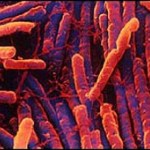transplant
By Hollingsworth John and Karen, U.S. Fish and Wildlife Service [Public domain], via Wikimedia Commons
Researchers are spending a lot of time exploring how the microbes living in our guts impact our health. In a new study published in Cell Reports, researchers wanted to know how the gut microbes of wild brown bears changes between summer and hibernation. They discovered that during the summer, the microbial species present in the gut are more diverse and are of the type that helps store energy. In fact, when the research team gave the microbes to rodents, the rodents gained…
Image of C. difficile from BBC News.
You may recall a prior post about a dog that could smell when patients were infected with Clostridium difficile. C. difficile causes about 14,000 deaths per year in the United States. Recent breakthroughs in understanding gut microbes have led to the successful treatment of C. difficile in patients. Fecal transplants, the transfer of feces from a healthy person, has been life-saving for some patients for whom medical treatments are not effective or for recurrent infections. Listen to Billie's story here. To date, feces have been…
Researchers at Massachusetts General Hospital (Boston) have successfully regenerated kidneys that were unsuitable for transplantation. They stripped the tissue of all native cells, then added donor stem cells to the scaffolding that was left behind. The re-animated kidneys successfully created urine after being transplanted into rats! The hope is to apply this technique to humans with end stage renal disease who are in need of kidney transplants and reportedly would work for the regeneration of other tissues as well.
The news was just publicly announced that the University of Maryland is now the 2nd hospital to perform full face transplant in the US. Just a handful of these procedures have been performed around the world, and they are enormously complex ethically, surgically and medically.
To begin with, long before the surgery even became a possibility, there have been years of work put into setting up such a novel transplant program. Besides obtaining approval for what is still an experimental procedure from an IRB, it is necessary to very carefully screen a population of potential recipients. A face…
Japanese scientists announced on Jan 22nd that they had made a huge breakthrough in fabricating human organs. Researchers from the Tokyo Institute of Technology successfully created a doll made of living cells.
The doll is about 1-inch tall and 5 mm wide, and is made from fully functioning cells. Scientists first created a mould for the doll's shape, then seeded it with 100,000 cell capsules - tiny 0.1 mm balls of collagen coated with cells which then were allowed to grow. The final result is a fully living structure that retains the cellular abilities for at least a day when suspended in…
